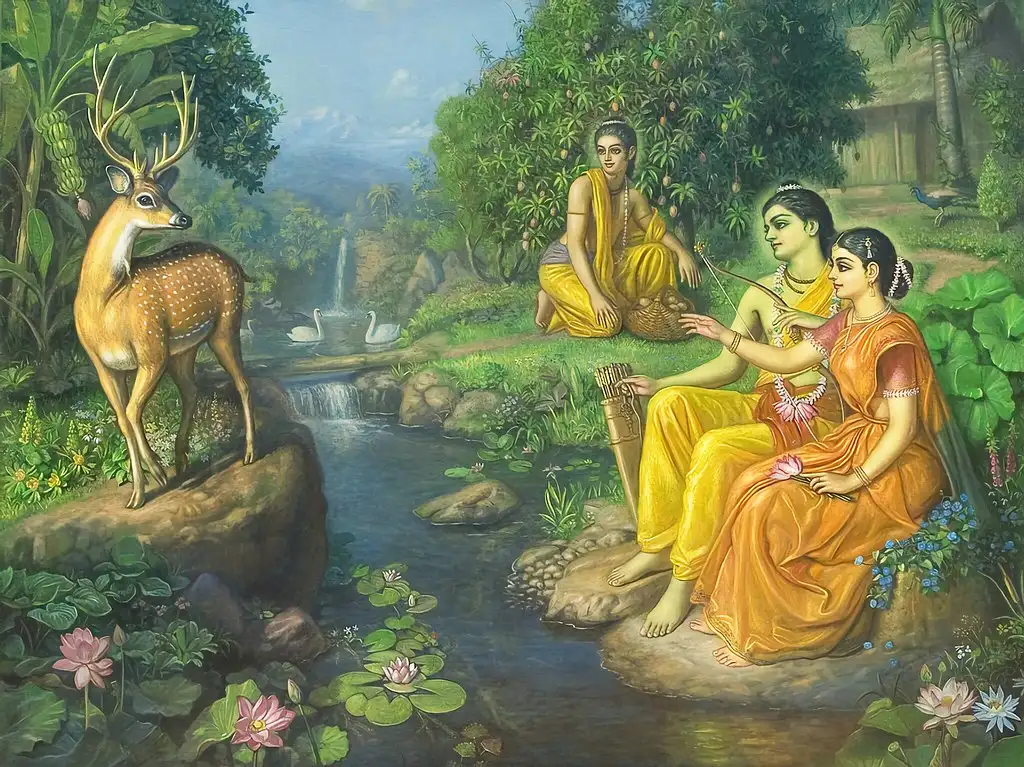The embodiment of the Supreme Brahman and Dharma, the touchstone of impeccable behavior, the paragon of the ideal human being, and the very incarnation of saumya rasa (Sanskrit: Harmonious Equilibrium). Lord Rama of Ayodhya is one of the most prominent deities in Hinduism and The story of his life is considered to be the greatest story of loyalty, love and greatness ever told, inculcating strong values in readers and shaping culture as we know it today.
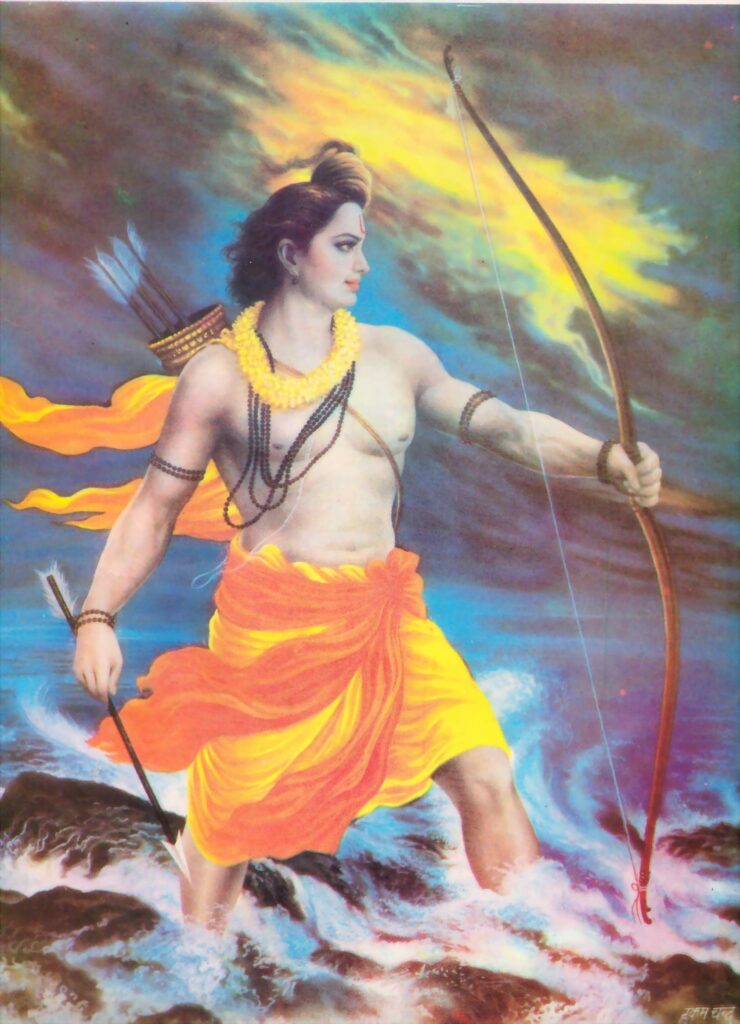
(Public Domain)
Who is Lord Rama?
Lord Rama (also Known as Rāmachandra or simply Ram) was the first in line to the throne of the kingdom of Kosala in Ayodhya and is revered throughout history as ‘Maryada Purushottam’ (Sanskrit: Supreme Man of Honour and Righteousness).
The personification of rectitude, virtue, and Chivalry, Rama was the seventh avatar (Sanskrit: incarnation) of Lord Vishnu and boasted a plethora of inherently good qualities such as loyalty, kindness, selflessness, bravery, and a strong sense of duty.
Rama is one of the most revered and widely worshipped Hindu deities today and is especially important in the Hindu Sect ‘Vaishnavism’. He is considered to be the most virtuous and popular incarnations of Lord Vishnu in human form, Vishnu manifested himself as titular protagonist Rama to restore cosmic order by Killing Ravana, and this tale of Rama’s triumph over the evil demon King Ravana became One of the greatest ancient Hindu epic poem The Ramayana.
Rama is considered to be the ultimate symbol of sacrifice, loyalty, and brotherhood. In addition to his kindness and virtuousness, Rama is also revered as one of the greatest warriors in human history – highly proficient in the art of archery – The story of Rama as the archer is seldom spoken about. The world needs to be reminded of what Rama was when he wielded his bow and with his strength and precision, killed the evil around him ever since he was a young prince.
Another notable aspect of Rama’s life is his epic love story with his wife – Sita. Devi Sita is often considered to be the avatar of Goddess Lakshmi and is known to be the representation of the ideal wife – endlessly loyal, faithful, and beautiful. Together, Rama and Sita depict the importance of love, devotion, faithfulness, and understanding in a relationship.
Birth of Rama
Rama was born to the Suryavanshi (Sanskrit: Solar dynasty) or the Ikshvaku dynasty King Dasharatha and his wife Queen Kausalya in the kingdom of Kosala during the Treta Yuga – the second of the four ages or phases of life.
Rama was considered to be a miracle child, as Dasharatha and Kausalya were faced with the inability to bear a child before he was conceived.
Dasharatha was the great warrior king of Ayodhya and was known to have three consorts – Kausalya, Sumitra and Kaikeyi. Despite this, Dasaratha was unable to provide an heir, a matter that was of great concern to him and his wives.
In a bid to change his luck, on one fateful day, Dasharatha invited his court guru – Sage Vashishth – in hopes of a solution to his problem. Luckily for him, Sage Vashishth knew of an ancient ritual – The Putrakameshi Yagya – and instructed the king to perform this ritual under the guidance of Sage Shringa Muni.

(Public Domain)
Delighted, Dasharatha carried out the ritual with fervor and on completion, was met by Agni Dev (Sanskrit: God Of Fire), who emerged from the flames with a vessel in his hand. Agni Dev informed Dasharatha that the vessel contained a divine sweet that would provide him with children if he distributed it among his wives. Overjoyed, Dasharatha made his way to Kausalya to consume this divine preparation first, followed by his wives Sumitra and Kaikeyi – which led to the birth of his sons Rama, Lakshmana, Shatrughna, and Bharatha respectively. Rama being the oldest son was the Crown Prince of Ayodhya.
Unbeknownst to Dasharatha and Kausalya however, was that Rama was an incarnation of Lord Vishnu on earth. Vishnu’s seventh avatar, Rama arrived on earth in a bid to rid the world of evil and spread righteousness – specifically to defeat the demon king Ravana.
However, in addition to his ultimate purpose of defeating Ravana, Rama underwent a series of ‘sidequests’, to banish evil from the world and restore cosmic order.
Rama and Sita
One of the greatest love stories of all time, Rama and Sita were destined to be together – through good times and bad. Sita was the daughter of Bhumi (Sanskrit: The Earth) and was adopted by the king and queen of Videha – Janaka and Sunayana. Considered one of the most beautiful princesses alive, suitors far and wide were desperate to meet Sita and to take her as a consort. Unbeknownst to her admirers, however, Sita was soon to meet Rama, who would soon become her soulmate and eternal companion.
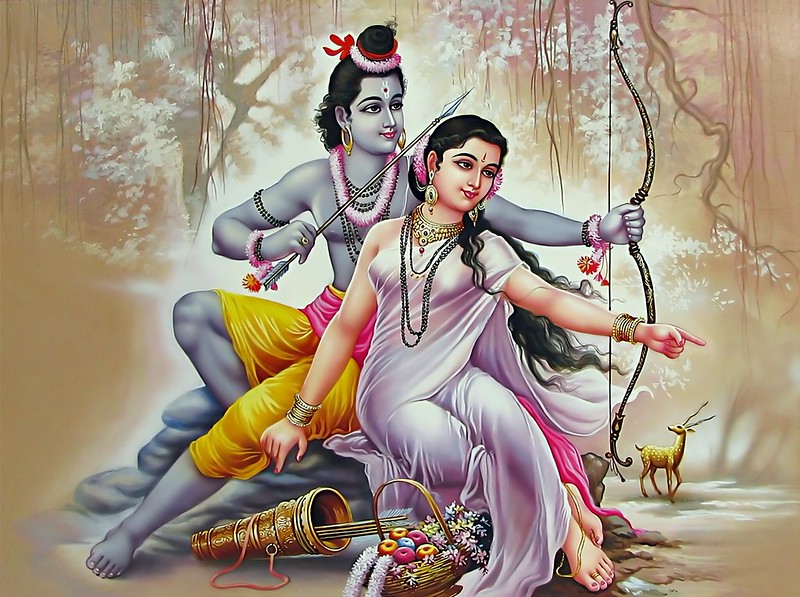
(Public Domain)
When Sita came of age, her father – King Janaka – decided to host a ‘Swayamwara’ (Sanskrit: To choose one’s husband), to find the best suitor for his daughter. Hence, he posed a challenge to all of Sita’s possible suitors – To string Pinaka, Lord Shiva’s bow. However, Janaka possessed the knowledge that Pinaka was too heavy to lift by ordinary human beings, and therefore, whoever managed to lift it would be the best possible husband for Sita.
Coincidentally, Vishvamitra, Ram and Lakshmana’s guru, heard about this large event and urged them to participate in it. After all, Rama had reached the marriageable age, and Sita seemed to be the best fit. The next day, Rama arrived at the event and managed to lift the bow with one hand and bring the string taut, which causes the bow to break. In awe and wonder, Janaka immediately selects Rama as Sita’s companion- much to both members’ delight. Soon after, Rama and Sita were married, a day that continues to be celebrated as ‘Vivaha Panchami’. Rama and Sita forged one of the greatest love stories of all time such that both their names are always mentioned in unison. ‘Jai Siya Ram’ which means ‘Glory to Sita and Ram’ has been firmly established as a common greeting used by devotees today.
Rama’s Exile From Ayodhya
First-in-line to the throne and married to one of the most beautiful princesses of all time, Rama was on the path to becoming one of the greatest Kings to rule over Ayodhya. However, when King Dashratha decided to pass down the crown to Rama, his second wife Kaykeyi had other plans for the throne.
Coaxed by her manipulative maid Manthara, Kaikeyi decided that she desired her son – Bharatha, Rama’s younger brother – to be made King. Legend has it that Kaykeyi possessed two boons from the King, which she had never used. Seizing the opportunity, Kaykeyi proceeded to use her boons, first demanding King Dasharatha to crown Bharatha king, and second demanding Rama to be exiled from Ayodhya for fourteen years. Unlike an ordinary human who would have reacted to a situation such as this with hostility and warfare, Rama accepted these terms without hesitation. Impassioned with a sense of duty towards his father and the throne, Rama believed that he must do his best to ensure his father would honor his word, and therefore, gracefully withdraw from the throne.
Although Bharatha’s mother had paved the way for him to ascend the Throne of Ayodhya, he refused when he learned about Rama’s exile. Appalled by his mother’s actions, Bharatha placed his shoes on the throne stating that they will remain there until Rama’s return, in a grand show of loyalty.
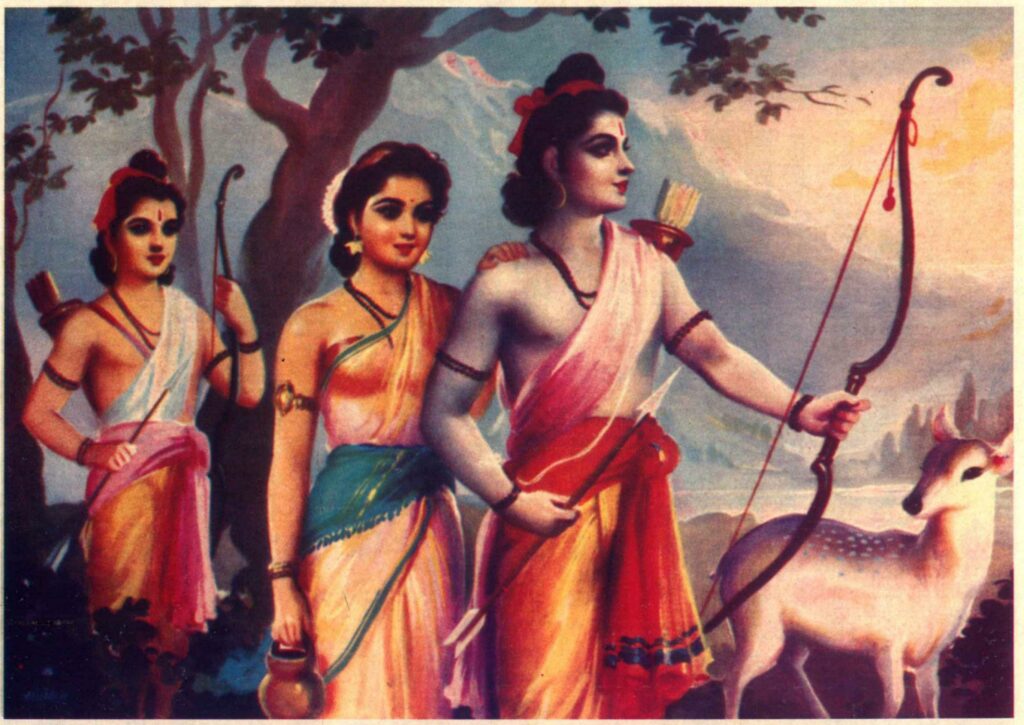
(Public Domain)
When Rama was ready to depart Ayodhya on his exile, Sita immediately declared that she would accompany him. Endlessly loyal, Sita was ready to give up the luxuries of palace life to accompany her husband. When Ram told her that he did not expect her to come with him, she is known to have said, “The forest where you dwell is Ayodhya for me, and Ayodhya without you is a veritable hell for me”. Lakshmana too was bound by loyalty to his brother. He accompanied Rama wherever he went, and the fourteen-year exile was no exception. Leaving his entire life behind, Lakshman set off with Rama and Sita to the Dandaka Forest on their laborious exile.
The Abduction of Rama’s Wife Sita
The kidnap of Sita and the war that ensued was set into motion by Shurpanakha, sister of Ravana, King of Lanka. On one unfortunate day, Shurpanakha set her eyes on Rama in the Panchavati forest and fell in love. To attract Rama, Shurpanakha disguised herself as a beautiful woman and appeared in front of him. Undyingly loyal to Sita, Rama rejected Shurpanakha, enraging her. This caused her to return to her original form and she tried to kill Sita. However, Lakshmana cut off Shurpanakha’s nose and sent her back to Lanka.

(Public Domain)
In a bid to take revenge on Rama, Ravana devised a plan to kidnap Sita. Ravana enlisted his uncle, the evil demon Maricha, to appear in front of Sita as a beautiful golden deer and entice her and lure her out from the safety of her hermitage. When Sita set her eyes on the deer, she was captivated by it, urging Rama to catch it for her. As Rama and Lakshman left their abode to catch the deer, Ravana kidnapped Sita, taking her to Lanka. In an attempt to protect Sita, Jatayu, the Vulture King confronted Ravana, who cut his wings off. However, Jatayu survived long enough to inform Rama about Ravana’s atrocities. Sita was taken to Ravana’s palace in Lanka, where she was held captive.
Hanuman and the Vanara Army
Rama and Lakshmana immediately set off to find Sita, during which they passed across the Land of Rishyamukha. Rishyamukh was the abode of Sugriva, The Monkey-King who was banished from his rightful home of Kishkindha by his brother Vali.
On spotting Rama and Lakshmana in the Dandaka forest, Sugriva became fearful that they were warriors of Vali. In an attempt to find out the intentions of these young warriors, Sugriva sent his minister – Hanuman – disguised as a ‘Sanyasi’ or Hermit. Hanuman approached Rama and Lakshmana and attempted to find out their true identities. On hearing their dilemma, Hanuman led Rama and Lakshmana to Sugriva.
Sugriva saw Rama as a reprieve from his condition and made a deal with him – If Rama killed Vali and reinstated Sugriva as the King of the Vanaras, he would help him find Sita. Rama agreed, and the two set off in search of Vali, killing him and reinstating Sugriva as King. To meet his end of the deal, Sugriva sent the Vanaras all across the world in an attempt to locate Sita. Ultimately, Hanuman found Sita in Lanka and returned to inform Rama of her location.
To Save Sita, Rama immediately began constructing a bridge With the help of the monkeys between Rameswaram Island, off the south-eastern coast of Tamil Nadu, India, and Mannar Island, off the north-western coast of Sri Lanka, This bridge was coined ‘Ram-Setu’ or Adam’s Bridge.
Ramayana Yuddha: The Great War
On the completion of the Ram-Setu, Rama, Lakshmana, and the Vanara army immediately crossed the bridge to head into battle – a fierce war that was waged for nearly seven days. It was a mighty war that was fought with bows and arrows, the atmosphere strife with tension.
Initially, Ravana stood atop a watch-tower while he sent his soldiers into war. Every soldier that Ravana sent in for battle was killed, angering him and causing him to take matters into his own hands. Before he set foot on the battlefield, he vowed that no matter what, he would ensure that Sita leaves a widow.
Hearing Ravana’s threat, The gods – Brahma, Shiva, and Indra- decide to help Rama, and they send Lord Indra’s Chariot – controlled by the charioteer Matali – to him. Lord Indra’s chariot was imbibed with celestial powers. Angered that Rama had the support of the Gods, Ravana begins to shoot arrows at Rama using all twenty of his arms. Rama’s arrows, however, neutralize the attack, and he remains unharmed by Ravana.
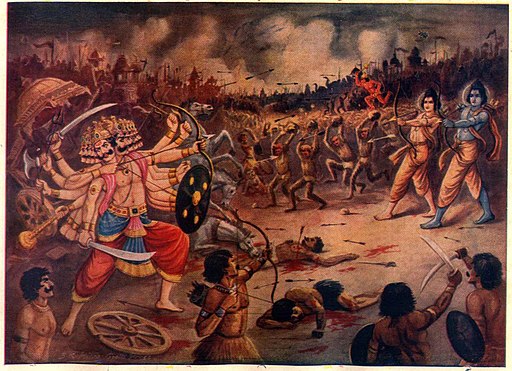
(Public Domain)
In the ensuing battle, Ravana, in a desperate attempt to salvage his army, makes use of ‘Astras’- Supernatural weapons imbibed with divine power. Rama however, due to his divine origin, manages to remain unscathed. Confident that he will remain victorious, Rama attempts to cut off Ravana’s many heads, which keep regenerating. Sensing his impending doom, Ravana makes his last attempt to win by hurling heavy objects at Rama. Rama, however, decides to end the fight and invokes a special Astra and hurls it at Ravana’s heart, killing him. As Ravana falls from the sky, he invokes Rama’s name and achieves Moksha – entrance to ‘Vaikuntam’(Sanskrit: Paradise).
Rama Returns To Ayodhya
Following Ravana’s defeat at Lanka, Rama, Sita, and Lakshman returned to Ayodhya, where they were welcomed with lights and celebrations since then been celebrated every year as ‘Diwali’ or Deepavali – The festival of lights. After Triumph over Ravana and completing exile tenure of 14 years Rama quickly assumed the throne as the rightful heir, with Sita by his side.

(Public Domain)
Rama Abandons Sita
This joy, however, was short-lived, as the residents of the Kingdom of Ayodhya became wary about Sita’s chastity after spending a full year in another man’s abode. Since Rama’s priority was his duty towards his subjects, He decided to leave Sita, who found refuge at Valmiki’s ashram, where she went on to give birth to and raise Rama’s sons – Luv and Kush, who went on to become great warriors.
How did Lord Ram Die?
It is said that Rama ruled over Ayodhya for 11,000 years, spending all his time devoted to his loyal subjects. One day, Kaal (Sanskrit: God of Time), disguised himself as a sage and visited Rama. He demanded an audience with the King and demanded no one enter the room. Sensing his true identity, Rama asked Lakshmana to guard the door while he spoke to the sage. The sage looked at him and said, “Your time on earth is over, you have fulfilled your purpose”. Realizing what is to be done, Rama walks into the river Sarayu until he is fully immersed. Lord Vishnu is then seen emerging from the lake, ascending into Vaikuntam, signifying Rama’s death.
The Legacy of Lord Ram
The embodiment of truth, loyalty, duty, and bravery, Lord Rama lives up to his title of ‘Maryada Purushottam’ – setting an example for his devotees to follow. He is the symbol of Goodness and exemplifies the moral standard that everyone should set for themselves. A very prominent Hindu deity, Lord Rama is also mentioned in Buddhist and Jain texts – often referred to as Pauma or Padma. Although his story may vary in Hinduism, Buddhism and Jainism, the essence of Rama remains the same – The ideal man.
The strong virtuousness of Lord Rama’s character makes him one of the most widely worshipped deities today, making the Ramayana the most recited book in various households, often having precedence over the Mahabharata, due to its strong lessons in ethics and values. The Ramayana is often recited to children to teach them the importance of these values. Lord Ram teaches one to inculcate these important ‘Hindu Values’ in one’s life, to shape the world into a better place. Other countries such as Japan have practiced these Hindu Values and hence have been able to attain their social and economic goals efficiently.
Even today, the most widely celebrated festivals are those devoted to Lord Rama, including – Diwali (Festival of Lights), Ram Navami (Celebration of Lord Rama’s Birth), and Dussehra (Festival marking the triumph of Rama over Ravana). In India, there are over 7000 temples dedicated to Lord Rama, adorned with shrines of his comrade Hanuman. “Ram!Ram!” and “Jai Siya Ram” are common greetings that are used every day among devotees and Rama’s name is the most invoked before death – as it is said that invoking Lord Rama’s name on your deathbed will grant you Moksha.
A tale as old as time, the greatest takeaway from the story of Lord Rama’s life is that the truth will out and good always triumphs over evil. A mesmerizing, multi-faceted, and deep-rooted part of our culture, Lord Rama has firmly established his position as one of the greatest deities to have ever graced the earth. Jai Siya Ram!


